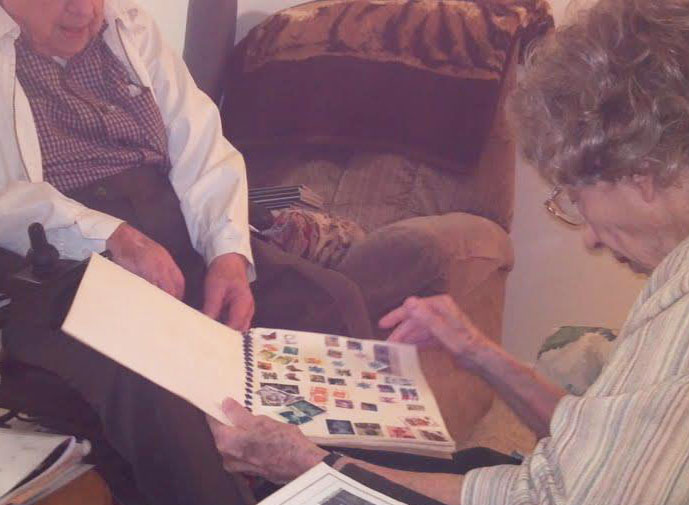My love language is handmade snail mail; Bob Beasley’s was sharing his stamp collection. Bob lived on the third floor of the same retirement home where Ms. Virginia once lived.
Bob Beasley & Ms. Virginia
Shortly after Ms. Virginia met Bob, she wrote me an email in all caps. I’m not sure if it was to express her excitement or if that was just how she wrote emails. While telling me all about Bob, she wrote, “he asked me to go upstairs to see his stamp collection, thats one I’ve never heard before.” Who knew stamps could ever sound so suggestive?
Like Bob, my grandfather also kept a stamp collection. He never told me about it. I just so happened to find it one day. My mom doesn’t even know that I kept it, although once I post this she will. Sorry mom.
Pop’s collection of stamps
The term philately is used to describe the study of stamps, but most likely you will be hard pressed to find a philatelist or stamp collector these days. Since it’s a seemingly dying art form, stamp designs and their histories are easily unknown - stashed away in books with disintegrating cover pages. Yet, before the prevalence of immediate communication via email, images designed for stamps were used as political strategies. Some stamps were said to have had the power to divide nations. Others may have been carriers of secret messages, sticky with propaganda.
Wikimedia Commons // Public Domain
Great Britain was the first to create a stamp. Her name was “Penny Black.” Before her creation in 1870, thousands of letters were mailed and never opened, words never read, because the recipient was often unable to pay for the postage fee.
Timestamped collection (with a neat 2017 thermochromic ink total solar eclipse of the sun stamp)
In all honesty, I probably wouldn’t have paid as much attention to stamps, if it weren’t for participating in a postcard exchange for a year. Every month I bought stamps to send out a batch of handmade postcards into the world in exchange for a new collection. Lucky me, I found some summer sweet treats in the form of scratch and sniff popsicle stamps.
From left to right: August 2017 collages on used classroom mats, September 2017 linocut prints of windows seen in Thailand, February 2018 folded paper prints of blue icebergs, December 2017 piece of pie linocut on painted paper, August 2018 thirtieth birthday beach collage, and September 2018 just add something blue (paint on gum prints)
Do you still send out old fashioned snail mail?




